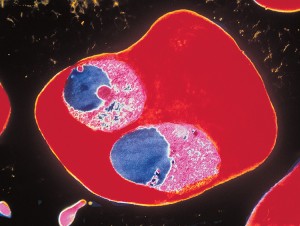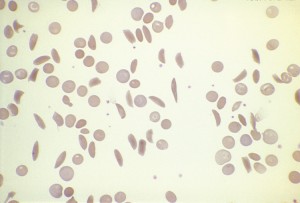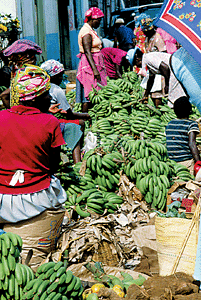Measles Returns
Wednesday, May 8th, 2019May 8, 2019
Measles is making a comeback. The highly contagious disease is characterized by the spotty pink rash it causes over the body. Once rare, measles has come roaring back in the United States, as more than 750 cases were officially recorded in the first four months of 2019. That number is more than twice the amount of U.S. cases typically recorded in a full year. The new measles cases were primarily recorded in large outbreaks in the states of New York and Washington, but the disease has also appeared in 21 other states.
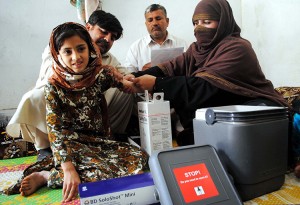
A health worker gives a measles vaccine to a young girl in Peshawar, Pakistan. Credit: © Asianet-Pakistan/Shutterstock
Measles chiefly strikes young children, but it is increasingly affecting adolescents and young adults. People who have the disease pass the virus by coughing and sneezing. People can spread the disease long before they realize they are ill. Three to five days after the first symptoms appear, faint pink spots break out over the body. Few people in the United States die of measles. But the disease is dangerous to those with a weakened immune system, and measles kills many undernourished children in other countries.
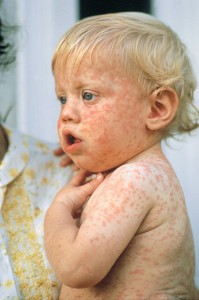
A child with measles shows the characteristic pink rash that spreads over the body. Credit: © Lowell Georgia, Photo Researchers
Public health experts are dismayed that measles has regained a foothold in the United States, where it was once eradicated. In 2000, the U.S. Centers for Disease Control and Prevention (CDC) announced that measles had been completely eliminated. This was an important public health achievement made possible by the widespread use of the highly effective measles vaccine. Of course, that did not mean that measles was completely gone. CDC officials still recorded a number of cases brought in from travelers—mostly from parts of Asia and Europe where measles is less well controlled. But, until recently, measles transmission in the United States had ended.
In recent years, however, a misinformed yet highly visible anti-vaccination (anti-vaxx for short) movement has led to fewer vaccinations, which has in turn led to the current measles outbreak. Anti-vaxx activists in the United States have launched a coordinated effort to convince parents not to vaccinate their children. They falsely claim that childhood vaccinations can cause a variety of health complications, autism, or even death. This disinformation is spread through websites, Facebook, and other social media. Medical professionals point out that anti-vaxx claims are often misleading and lack any credible or relevant evidence.
The anti-vaxx movement has spearheaded efforts to allow parents to opt out of mandatory vaccinations previously require to enroll their children in public schools. The latest measles outbreak is spread primarily though such unvaccinated students, who expose other children to measles and other preventable diseases, such as whooping cough.
Unvaccinated people, including those who may have a weakened immune system from chemotherapy, can be protected from measles through herd immunity. This term describes a population protected from a disease because high rates of vaccination make it impossible for the virus to spread. Although the measles virus can remain infectious for two or more hours outside the human body, the virus ultimately requires a human host to reproduce. If enough people in a population are vaccinated, the cycle of transmission is disrupted, and the virus will become extinct.
However, herd immunity does not work unless a great majority of the population is vaccinated. To achieve herd immunity for measles, at least 90 to 95 percent of the population needs to be vaccinated. In the past, this was achieved through mandatory vaccinations for school children. In recent years, however, increasing numbers of parents have requested vaccine exemptions for their children on ethical or religious grounds. Many states, cities, and school districts are now reconsidering allowing such exemptions.


